Anna Academic Store
Quality Verified & up-to-date Academic Papers!!
- 1033
- 0
- 0
Community
- Followers
- Following
2 Reviews received
1033 items

TNCC Exam 9th Edition Study Guide | 100% Correct Answers | Verified | Latest 2024 Version
A 35-year-old male presents with facial trauma after being struck in the face with a baseball. A teardropshaped left pupil is noted on exam. What type of injury is suspected? - Globe rupture A teardropshaped pupil suggests a globe rupture. .A patient with a complete spinal cord injury in neurogenic shock will demonstrate hypotension and which other clinical signs? - Bradycardia and absent motor function below the level of injury Patients with a complete spinal cord injury will have absent mot...
- Exam (elaborations)
- • 8 pages •
A 35-year-old male presents with facial trauma after being struck in the face with a baseball. A teardropshaped left pupil is noted on exam. What type of injury is suspected? - Globe rupture A teardropshaped pupil suggests a globe rupture. .A patient with a complete spinal cord injury in neurogenic shock will demonstrate hypotension and which other clinical signs? - Bradycardia and absent motor function below the level of injury Patients with a complete spinal cord injury will have absent mot...

TNCC 9th Edition Test Prep | 100% Correct Answers | Verified | Latest 2024 Version
3 parts of the trauma triad of death - Hypothermia, coagulopathy, metabolic acidosise 3 things to assess for circulation - Palpate central pulse Assess (again) for external hemorrhage Inspect and palpate skin for color, temp, and moisture. 3 ways to assess ETT placement - 1. Apply end tidal, assess CO2 after 5-6 breaths 2. Assess for symmetrical chest wall rise and fall 3. Auscultation over the epigastrium for gurgling and bilateral breath sounds. At what point to you evaluate need fo...
- Exam (elaborations)
- • 5 pages •
3 parts of the trauma triad of death - Hypothermia, coagulopathy, metabolic acidosise 3 things to assess for circulation - Palpate central pulse Assess (again) for external hemorrhage Inspect and palpate skin for color, temp, and moisture. 3 ways to assess ETT placement - 1. Apply end tidal, assess CO2 after 5-6 breaths 2. Assess for symmetrical chest wall rise and fall 3. Auscultation over the epigastrium for gurgling and bilateral breath sounds. At what point to you evaluate need fo...
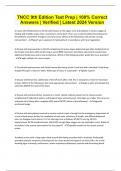
TNCC 9th Edition Test Prep | 100% Correct Answers | Verified | Latest 2024 Version
A 5-year-old child presents to the ED with bruises to the upper arms and buttocks in various stages of healing and multiple small, clean, round burns to the back. There are no abnormalities found based on the pediatric assessment triangle or primary survey. Which of the following is the priority nursing intervention? - Report your suspicion of maltreatment in accordance with local regulations A 20-year-old male presents to the ED complaining of severe lower abdominal pain after landing hard ...
- Exam (elaborations)
- • 6 pages •
A 5-year-old child presents to the ED with bruises to the upper arms and buttocks in various stages of healing and multiple small, clean, round burns to the back. There are no abnormalities found based on the pediatric assessment triangle or primary survey. Which of the following is the priority nursing intervention? - Report your suspicion of maltreatment in accordance with local regulations A 20-year-old male presents to the ED complaining of severe lower abdominal pain after landing hard ...

TNCC Final Exam 2024 Open Book | 100% Correct Answers | Verified | Latest 2024 Version
A 5-year old child presents to the ED with bruises to the upper arms and buttocks in various stages of healing and multiple small, clean, round burns to the back. There are no abnormalities found based on the pediatric assessment triangle or primary survey. Which of the following is the priority nursing intervention? A) report your suspicion of the maltreatment in accordance with local regulations B) apply ice to the bruises and consult wound care C) engage in therapeutic communication to ...
- Exam (elaborations)
- • 15 pages •
A 5-year old child presents to the ED with bruises to the upper arms and buttocks in various stages of healing and multiple small, clean, round burns to the back. There are no abnormalities found based on the pediatric assessment triangle or primary survey. Which of the following is the priority nursing intervention? A) report your suspicion of the maltreatment in accordance with local regulations B) apply ice to the bruises and consult wound care C) engage in therapeutic communication to ...
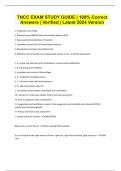
TNCC EXAM STUDY GUIDE | 100% Correct Answers | Verified | Latest 2024 Version
1. Preparation and Triage 2. Primary Survey (ABCDE) with resuscitation adjuncts (F,G) 3. Reevaluation (consideration of transfer) 4. Secondary Survey (HI) with reevaluation adjuncts 5. Reevaluation and post resuscitation care 6. Definitive care of transfer to an appropriate trauma nurse - Initial Assessment 1. A- airway and Alertness with simultaneous cervical spinal stabilization 2. B- breathing and Ventilation 3. circulation and control of hemorrhage 4. D - disability (neurologic stat...
- Exam (elaborations)
- • 13 pages •
1. Preparation and Triage 2. Primary Survey (ABCDE) with resuscitation adjuncts (F,G) 3. Reevaluation (consideration of transfer) 4. Secondary Survey (HI) with reevaluation adjuncts 5. Reevaluation and post resuscitation care 6. Definitive care of transfer to an appropriate trauma nurse - Initial Assessment 1. A- airway and Alertness with simultaneous cervical spinal stabilization 2. B- breathing and Ventilation 3. circulation and control of hemorrhage 4. D - disability (neurologic stat...

TNCC Final Exam 2024 Open Book | 100% Correct Answers | Verified | Latest 2024 Version
A patient arrives with a large open chest wound after being assaulted with a machete, Prehospital providers placed a nonporous dressing over the chest wound and tapes it on 3 sides. He is now showing signs of anxiety, restlessness, severe respiratory distress, cyanosis, and decreasing blood pressure. Which of the following is the MOST appropriate interventions? A) needle decompression B) tube thoracostomy C) dressing removal D) surgical repair - C) dressing removal A patient has been in ...
- Exam (elaborations)
- • 8 pages •
A patient arrives with a large open chest wound after being assaulted with a machete, Prehospital providers placed a nonporous dressing over the chest wound and tapes it on 3 sides. He is now showing signs of anxiety, restlessness, severe respiratory distress, cyanosis, and decreasing blood pressure. Which of the following is the MOST appropriate interventions? A) needle decompression B) tube thoracostomy C) dressing removal D) surgical repair - C) dressing removal A patient has been in ...

TNCC EXAM STUDY GUIDE | 100% Correct Answers | Verified | Latest 2024 Version
labs, wound care, tetanus, administer meds, prepare for transfer - Secondary Reval Adjuncts Vital signs Interventions Primary survey Pain - Post resuscitation care parameters that are continuously evaluated: Capnography monitors numeric value, as well as continuous waveform, indicating real-time measurement and trending over time. - Quantitative: Colorimetric CO2 detectors provide info about the presence or absence of CO2. A chemically treated indicator strip changes color revealing the pr...
- Exam (elaborations)
- • 6 pages •
labs, wound care, tetanus, administer meds, prepare for transfer - Secondary Reval Adjuncts Vital signs Interventions Primary survey Pain - Post resuscitation care parameters that are continuously evaluated: Capnography monitors numeric value, as well as continuous waveform, indicating real-time measurement and trending over time. - Quantitative: Colorimetric CO2 detectors provide info about the presence or absence of CO2. A chemically treated indicator strip changes color revealing the pr...
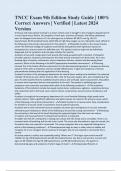
TNCC Exam 9th Edition Study Guide | 100% Correct Answers | Verified | Latest 2024 Version
A 56-year-old male patient involved in a motor vehicle crash is brought to the emergency department of a rural critical access facility. He complains of neck pain, shortness of breath, and diffuse abdominal pain. His Glasgow Coma Score is 15. His vital signs are as follows: BP 98/71 mm Hg, HR 125 beats/minute, RR 26 breaths/minute, SpO2 94% on high-flow oxygen via non-rebreather mask. Which of the following is the priority intervention for this patient? - Expedite transfer to the closest tra...
- Exam (elaborations)
- • 5 pages •
A 56-year-old male patient involved in a motor vehicle crash is brought to the emergency department of a rural critical access facility. He complains of neck pain, shortness of breath, and diffuse abdominal pain. His Glasgow Coma Score is 15. His vital signs are as follows: BP 98/71 mm Hg, HR 125 beats/minute, RR 26 breaths/minute, SpO2 94% on high-flow oxygen via non-rebreather mask. Which of the following is the priority intervention for this patient? - Expedite transfer to the closest tra...
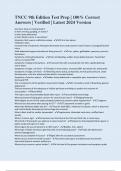
TNCC 9th Edition Test Prep | 100% Correct Answers | Verified | Latest 2024 Version
Are there loose or missing teeth? Is there snoring, gurgling, or stridor? Is there bony deformity? Is there blood, vomit, or secretions? Situations that require a definitive airway - GCS 8 or less Apnea Inhalation injury Increased risk of aspiration Anticipate decreased neuro status Severe maxo fractures Laryngeal/tracheal injury Solid abdominal organs and what are they prone to? - Liver, spleen, gallbladder, pancreas, prone to lacerations Symptoms of abruptly placentae - Dark red blee...
- Exam (elaborations)
- • 2 pages •
Are there loose or missing teeth? Is there snoring, gurgling, or stridor? Is there bony deformity? Is there blood, vomit, or secretions? Situations that require a definitive airway - GCS 8 or less Apnea Inhalation injury Increased risk of aspiration Anticipate decreased neuro status Severe maxo fractures Laryngeal/tracheal injury Solid abdominal organs and what are they prone to? - Liver, spleen, gallbladder, pancreas, prone to lacerations Symptoms of abruptly placentae - Dark red blee...
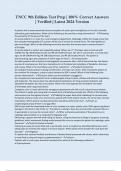
TNCC 9th Edition Test Prep | 100% Correct Answers | Verified | Latest 2024 Version
A patient with a lower extremity fracture complains of severe pain and tightness in his calf, minimally relieved by pain medications. Which of the following is the priority nursing intervention? - Elevating the extremity TO the level of the heart A trauma patient is en route to a rural emergency department. Radiology notifies the charge nurse that the computed tomography (CT) scanner will be out of service for several hours. The team gathers to plan accordingly. Which of the following terms...
- Exam (elaborations)
- • 4 pages •
A patient with a lower extremity fracture complains of severe pain and tightness in his calf, minimally relieved by pain medications. Which of the following is the priority nursing intervention? - Elevating the extremity TO the level of the heart A trauma patient is en route to a rural emergency department. Radiology notifies the charge nurse that the computed tomography (CT) scanner will be out of service for several hours. The team gathers to plan accordingly. Which of the following terms...

2023 AQA A-level ACCOUNTING 7127/1 Paper 1 Financial Accounting Question Paper & Mark scheme (Merged) June 2023 [VERIFIED]
2023 AQA A-level ACCOUNTING 7127/1 Paper 1 Financial Accounting Question Paper & Mark scheme (Merged) June 2023 [VERIFIED]